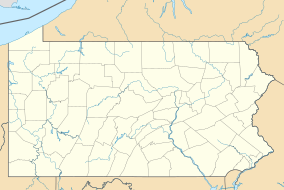Tionesta Scenic and Research Natural Areas
| Tionesta Scenic and Research Natural Areas | |
|---|---|
 East Fork Run, McKean County, within the Tionesta Research Natural Area of Allegheny National Forest | |
Map of Pennsylvania | |
| Location | McKean County, Pennsylvania |
| Nearest city | Kane |
| Area | 4,131 acres (1,672 ha) |
| Designated | 1973 |
The Tionesta Scenic and Research Natural Areas are adjacent protected areas in the Allegheny National Forest of northwestern Pennsylvania. They cover a combined 4,131 acres (1,672 ha) of the Allegheny Plateau and contain some 4,000 acres (1,600 ha) of old-growth forest representative of the area. They are located in Wetmore Township, McKean County, Pennsylvania, near Kane.
History
The areas are a remnant of the original forest that once covered 6 million acres (24,000 km2) on the Allegheny Plateau of New York and Pennsylvania. The old growth forest consists of 300- to 400-year-old American beech, Eastern hemlock and some sugar maple. Other tree species are yellow birch, sweet birch, black cherry, red maple, American basswood, tulip poplar, and cucumber magnolia. It is the type of forest that greeted early settlers and later supported a vast lumber industry.
The tract of old growth was purchased by the federal government in 1936. The Scenic Area was dedicated for aesthetic purposes and the remaining area was set aside as a Research Natural Area for scientific studies.
In 1973, both areas were added to the National Registry of National Natural Landmarks Program in recognition of their unique status.[1]
During early evening hours of May 31, 1985, a devastating tornado moved through the northern half of Tionesta Scenic Area. Its destructive wake can still be seen, a reminder of natural powers well beyond human control.
Natural features
This secluded area is nearly roadless and offers great opportunities for solitude and nature study. You may encounter white-tailed deer, American black bear, fishers, and several bat species. Bird watchers can search for numerous species that prefer old growth forests, like barred owls, northern goshawks, pileated woodpeckers, flycatchers, thrushes, and warblers.
The area is a typical plateau cut by streams, with flat uplands and steep-sided valleys. Elevations range from 1,500 feet (460 m) in stream bottom areas, to 1,960 feet (600 m) on plateau tops. Large rock outcrops can be found throughout this area.
Trails
A portion of the North Country National Scenic Trail passes through the Tionesta Scenic Area.
The Twin Lakes Trail, marked with gray diamonds, traverses the southern part of the Scenic Area. This trail connects the North Country Trail with Twin Lakes Recreation Area and is 15.8 miles (25.4 km) long.
The other trails that take off from the entrance road are not maintained.
See also
References
- Mary Byrd Davis (23 January 2008). "Old Growth in the East: A Survey. Pennsylvania" (PDF).
- United States Forest Service. "Allegheny National Forest - Tionesta Scenic Area".
- Pennsylvania Department of Conservation and Natural Resources. "Tionesta Natural Area".
- 41°39′53″N 78°56′59″W / 41.66472°N 78.94972°W Tionesta Scenic Area
- 41°38′38″N 78°56′14″W / 41.64389°N 78.93722°W Tionesta Natural Area

